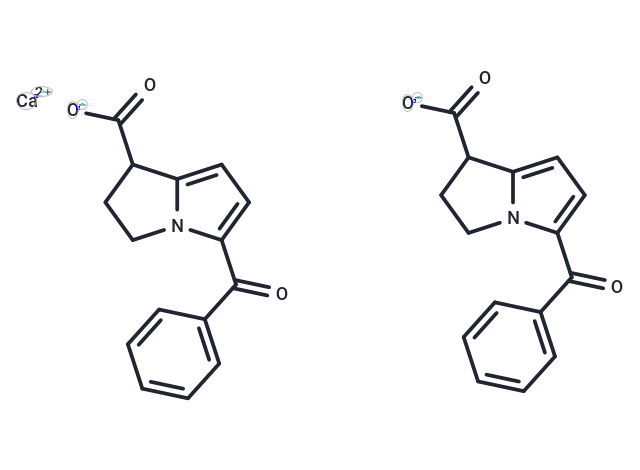Shopping Cart
Remove All Your shopping cart is currently empty
Your shopping cart is currently empty
Ketorolac (RS37619) hemicalcium is a nonselective COX inhibitor with IC50 values of 20 nM for COX-1 and 120 nM for COX-2. This non-steroidal anti-inflammatory drug (NSAID) is used as a 0.5% ophthalmic solution for researching allergic conjunctivitis, cystoid macular edema, intraoperative miosis, and postoperative ocular inflammation and pain. Additionally, it is a DDX3 inhibitor applicable in cancer research [1] [4].

| Pack Size | Price | USA Warehouse | Global Warehouse | Quantity |
|---|---|---|---|---|
| 1 g | $1,290 | 35 days | 35 days |
| Description | Ketorolac (RS37619) hemicalcium is a nonselective COX inhibitor with IC50 values of 20 nM for COX-1 and 120 nM for COX-2. This non-steroidal anti-inflammatory drug (NSAID) is used as a 0.5% ophthalmic solution for researching allergic conjunctivitis, cystoid macular edema, intraoperative miosis, and postoperative ocular inflammation and pain. Additionally, it is a DDX3 inhibitor applicable in cancer research [1] [4]. |
| In vitro | Ketorolac (RS37619) salt effectively targets oral cancer cells, demonstrating potent cytotoxicity across various concentrations and exposure times. Within a 48-hour timeframe, concentrations up to 30 μM significantly decrease oral cancer cell viability, with specific concentration ranges (0-5 μM) reducing DDX3 protein levels and triggering apoptosis in H357 cells, suggesting a mechanism of action linked to the inhibition of DDX3 protein function and ATPase activity. Notably, concentrations as low as 0-2.5 μM over periods up to 16 hours suppress cell proliferation, highlighting its potent antiproliferative effects. Comprehensive cell viability and proliferation assays across different cell lines, including HOK, SCC4, SCC9, and H357, further elucidate its selective toxicity, displaying inhibitory concentration (IC50) values of 2.6, 7.1, and 8.1 μM against H357, SCC4, and SCC9 cells, respectively, while sparing normal HOK cells. Moreover, Western blot analysis confirms the dose-dependent downregulation of DDX3 protein and upregulation of E-cadherin, aligning with the apoptosis analysis which shows induced apoptosis at concentrations of 2.5 and 5 μM after 48 hours, affirming the compound's potential as a targeted therapeutic agent for oral cancer treatment. |
| In vivo | Ketorolac (RS37619), as a 0.4% ophthalmic solution, demonstrates significant anti-inflammatory effects in rabbits' eyes, nearly completely inhibiting LPS-induced increases in fluorescein isothiocyanate-dextran and aqueous PGE2 concentrations in the anterior chamber. In rats, a daily oral dose of 4 mg/kg for two weeks does not adversely affect the volume fraction of bone trabeculae in the alveolar socket. Furthermore, a single intrathecal injection of 60 μg ketorolac significantly reduces motor disturbances and improves survival rates in a spinal cord ischemia model in rats. Additionally, intraperitoneal injections of ketorolac salt at doses of 20 and 30 mg/kg twice weekly for three weeks decrease oral tumor growth and downregulate DDX3 and anti-apoptotic proteins (Bcl-2 and Mcl-1) in a mouse model of oral carcinogenesis. |
| Molecular Weight | 548.608 |
| Formula | C30H24CaN2O6 |
| Cas No. | 167105-81-9 |
| Smiles | [Ca++].[O-]C(=O)C1CCn2c1ccc2C(=O)c1ccccc1.[O-]C(=O)C1CCn2c1ccc2C(=O)c1ccccc1 |
| Storage | Powder: -20°C for 3 years | In solvent: -80°C for 1 year | Shipping with blue ice/Shipping at ambient temperature. |
| Size | Quantity | Unit Price | Amount | Operation |
|---|

Copyright © 2015-2026 TargetMol Chemicals Inc. All Rights Reserved.